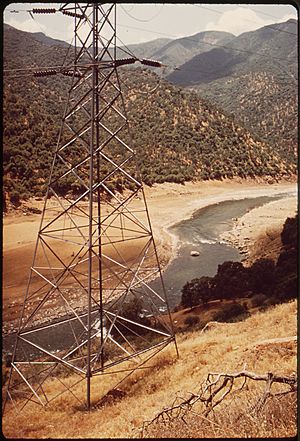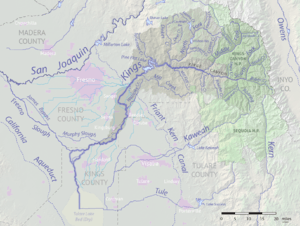North Fork Kings River facts for kids
Quick facts for kids North Fork Kings River |
|
|---|---|

North Fork Kings River
|
|

Map of the Kings River watershed, including the North Fork
|
|
| Country | United States |
| State | California |
| Physical characteristics | |
| Main source | Sierra Nevada Fresno County 11,280 ft (3,440 m) 37°03′48″N 118°44′05″W / 37.06333°N 118.73472°W |
| River mouth | Kings River Rodgers Crossing, Fresno County 1,020 ft (310 m) 36°52′10″N 119°08′06″W / 36.86944°N 119.13500°W |
| Length | 40.3 mi (64.9 km) |
| Basin features | |
| River system | Kings River basin |
| Basin size | 387 sq mi (1,000 km2) |
| Tributaries |
|
The North Fork Kings River is a cool river in California. It's about 40 miles (65 km) long and flows into the larger Kings River. This river is entirely within Fresno County. Its watershed, which is the area of land that drains into the river, covers about 387 square miles (1,000 km²) in the southern Sierra Nevada mountains.
Contents
The River's Journey
The North Fork Kings River starts high up in the Sierra National Forest. It begins at an elevation of about 11,380 feet (3,470 meters). This starting point is an unnamed pond, about a mile south of Mount Reinstein.
Flowing Through the Mountains
The river first flows west through a high area with many lakes. Then, it drops into a very deep valley. Along its way, it gets water from smaller streams like Post Corral Creek and Helms Creek.
Reservoirs and Tributaries
The river then flows into Wishon Reservoir, which is a large lake created by the Wishon Dam. After Wishon Reservoir, the river turns south and enters a deep gorge. It receives Rancheria Creek from the left side.
Next, it flows southwest into Black Rock Reservoir. After this reservoir, it continues west and gets more water from Patterson Creek. The river is then held back again by a small dam. Soon after, it meets Dinkey Creek, which is its biggest tributary. This happens at a place called Balch Camp. Finally, the North Fork Kings River turns south and flows into the main Kings River near Rodgers Crossing.
How the River Powers Our Lives
The North Fork Kings River is very important for making electricity. There's a big system of hydroelectric power plants along its course. These plants use the power of flowing water to create energy.
Power Plants and Dams
Below the Wishon Dam, the North Fork Kings River drops a lot in elevation. This big drop is perfect for generating electricity. Water from Wishon Reservoir travels through a 6-mile (10 km) long tunnel. This tunnel leads to the Haas Powerhouse, which is built underground. Here, the water falls about 850 feet (260 meters) to spin large turbines and create 128 megawatts of power.
Black Rock Reservoir plays a dual role. It holds water after it leaves the Haas Powerhouse. It also acts as the starting point for water going to the Balch Powerhouse, which is about 3 miles (5 km) downstream. Even further down, the Kings River Powerhouse releases water directly into Pine Flat Lake.
History of Power Generation
The Balch Powerhouse is one of the oldest power plants on the Kings River. It was first built in 1927 by a company called San Joaquin Light & Power. This company later became part of Pacific Gas and Electric Company (PG&E). After PG&E took over, they planned and built the Haas Powerhouse, which was finished in 1959. The large storage dams at Wishon and Courtright Reservoir were completed in 1962.
For a while in the 1940s, there was a debate about who should develop the North Fork system. Farmers were worried that a government plan might move water away from their local farms. However, PG&E, a private company, promised to keep all the water within the Kings River system. This meant more water would be available for local use. In 1949, PG&E was allowed to build the Wishon and Courtright dams.
Pumped Storage Power
The Wishon Reservoir and Courtright Reservoir are also part of a special power plant called the Helms Pumped Storage Plant. This plant is one of the largest of its kind in the United States, producing 1,212 megawatts of power.
Here's how it works: When there isn't much demand for electricity (like at night), water is pumped uphill from Wishon Reservoir to Courtright Reservoir. Then, when a lot of electricity is needed (like during the day), the water is released back down to Wishon Reservoir. As it flows downhill, it spins turbines to generate extra power, known as peaking power. PG&E also owns this plant, which was built between 1977 and 1984.

